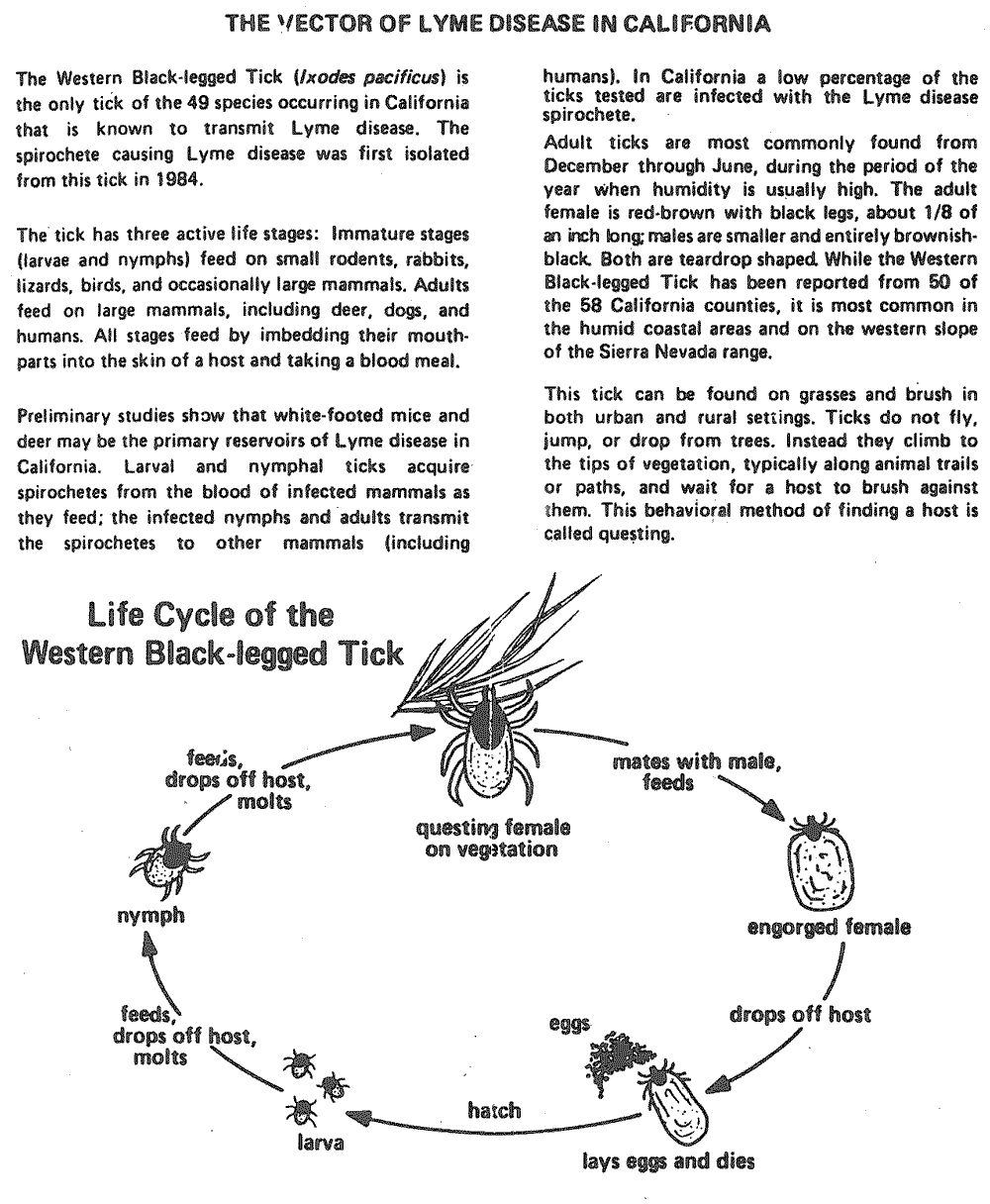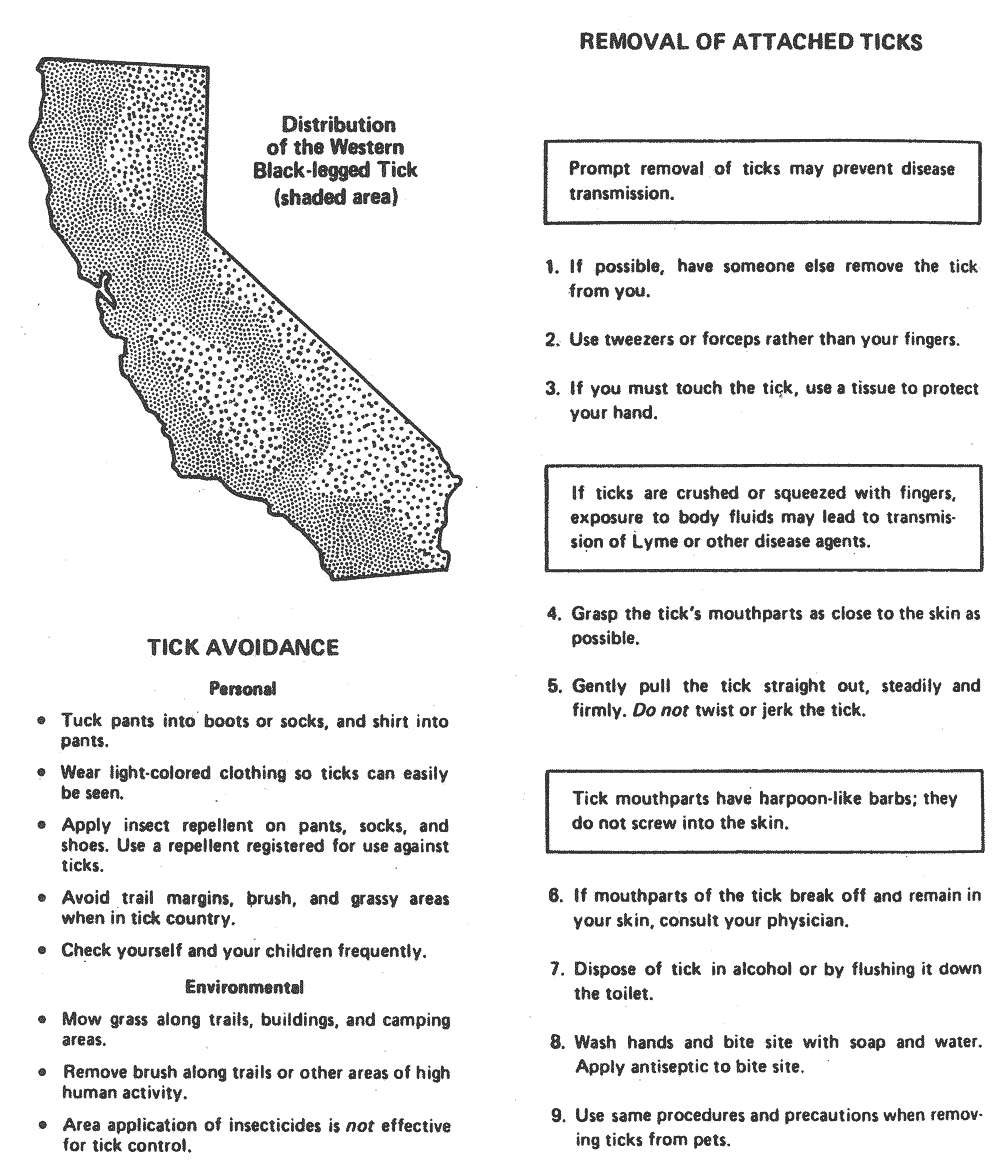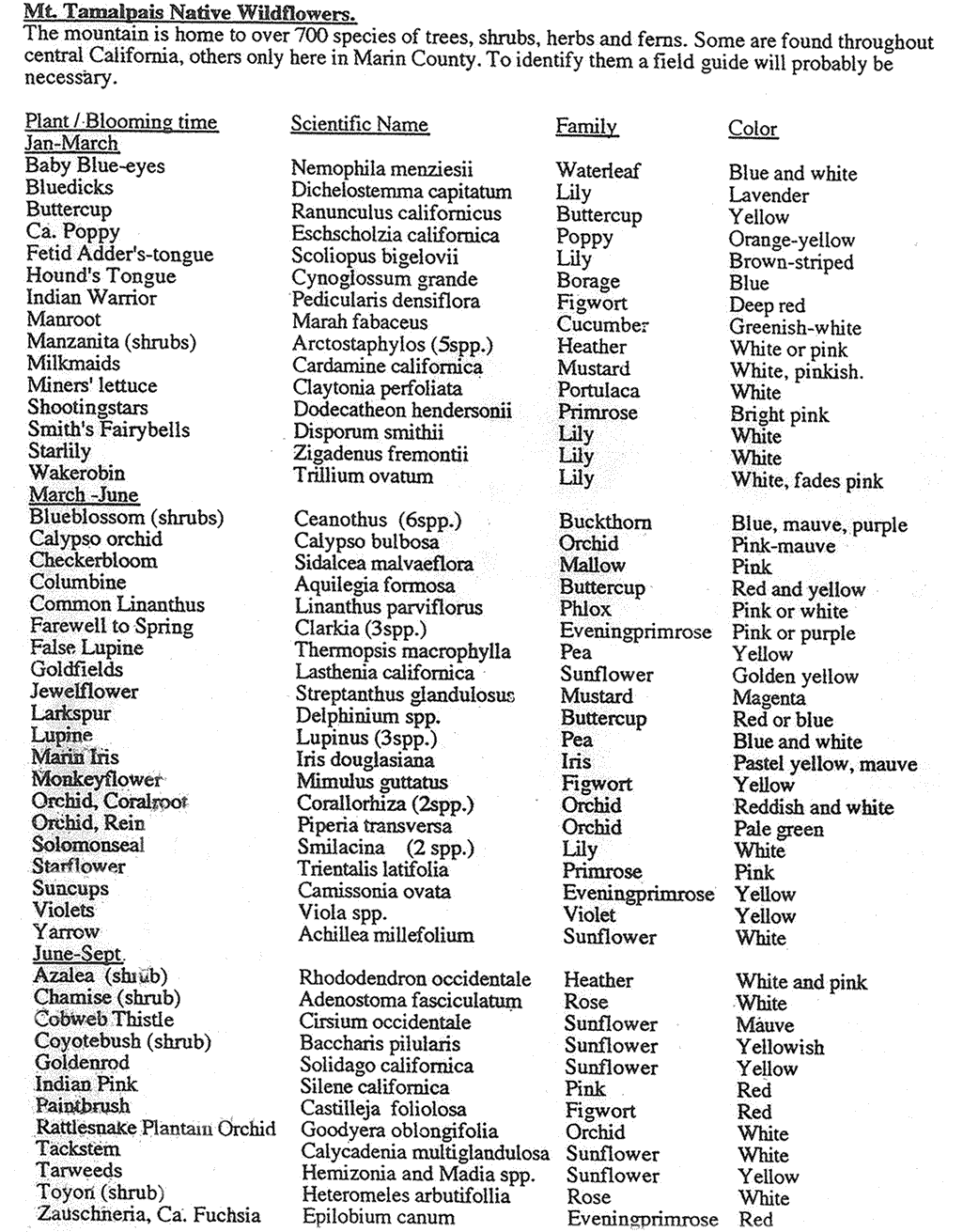



Page Contents: 1. Hiker's Checklist 2. Safe Heart/Pulse Rate 3. Ticks on Mt. Tamalpais 4. Wild Flowers on Mt. Tamalpais 4. Lichens
This is the short list of some reminders from San
Francisco Walt to help you get the most enjoyment out of hiking over the
trails on Mt. Tamalpais:
1. Keeping your body hydrated is one of the most important
things you must do in hot weather. Carry a good supply of water. Bring an extra
bottle/canteen of water and a belt or bag/backpack to carry it.
2. Wear hiking boots with lug soles (if your have them) to
grip the earth and rocks and keep your feet dry. In the Spring time, especially
after a rain, there can be big puddles and lots of muddy trails
3. Bring sandals to leave in the car while hiking and put
on after the hike to let your feet enjoy the air. If the trails are muddy, your
boots will get muddy. You don't want to wear muddy boots in the car. Put on your
sandals or other shoes to wear in th car after the hike. Put the muddy boots in
a plastic shopping bag to carry home. Bring a plastic (shopping) bag for each
pair of boots for that purpose.
4. Bring a hat to wear to protect your head from the sun.
No sunstrokes allowed on hikes. (Also, if a tick falls on your head from an
overhanging tree branch, it will be easier to detect before getting to your
skin.)
5. Sunscreen lotion. Generous amount on ears, back of neck,
nose, back of hands, smiling face, etc. Apply before you dress for hike to let
it soak in and not stain clothes. Make an exception to your "no-lipstick" rule
when you go hiking in the summer and put on some lip chap or lipstick
after eating to protect your lips from the sun and keep
them moisturized.
6. If it is a hot day: Loose, long sleeve, light cotton,
button up shirt with collar (if you have). Something you can wear w/o underwear
or halter so that air can circulate around your skin and not have
perspiration-wet clothing sticking to your skin. A pair of light, cotton, long
pants will retain more body moisture than if you wear a pair of shorts. Long
pants tucked into your socks will give you protection from little, sneaky, black
ticks (which may carry lyme disease) from climbing up your leg inside your
pants.
7. A short sleeve t-shirt to carry in your back pack. If a
chilly, ocean driven fog creeps in while on the trail, you can put it on over
your shirt as a wind break to keep warm.
8. Lunch. Bring whatever you like. Consider the fact that
your body is going to be burning caloris and losing much greater amounts of
water than you are normally used to in a short period of time. So, think of
bringing something that will absorb no water or little water from your
circulatory
system. If you like cucumbers, apples or juicy fruit, bread
and maybe some cheese is a good combination. Bring some salt to put on the food.
A little salt intake (especially in hot weather) is a heat stroke deterrent.
Bring one or two plastic bags like the ones you use when
you buy fruits or vegetables. For garbage/multi-purpose use.
Take nothing but photos. Leave nothing but footprints.
9. Bring your swiss army knife if you
have one. It's an invaluable tool on a hike.
10. Bring a couple of wet wipes to carry in your back pack
if you have them. Also carry some band aids in your back pack in a small plastic
bag in case you scrape or cut yourself.
11. Bring about 12 to 16 sections of toilet paper
(multi-use potential on hikes) wrapped up in a sealable/waterproof plastic bag.
12. Arrive on the mountain with a happy, child-like
curiosity and wanderlust spirit.
Eat a good breakfast combo of protein and carbohydrates.
The carbohydrates will give you energy in the early hours, the protein converts
to glucose (and energy) about 5 hours after intake.
MAXIMUM
PULSE/HEART RATE AND TARGET RANGE FOR HIKER'S HEALTH
http://www.heart.org/HEARTORG/GettingHealthy/PhysicalActivity/Target-Heart-Rates_UCM_434341_Article.jsp
First Thing’s First
Before you learn how to
calculate and monitor your target training heart rate, you have to know your
resting heart rate. Your resting heart rate is the number of times your heart
beats per minute while it’s at rest.
It’s best to check it in the morning after you’ve had a good night’s sleep and
before you get out of bed. The average resting heart rate is 60-80 beats per
minute, but it’s usually lower for physically fit people. It also rises
with age.
Hitttin’ the Target
Now you’re ready to
determine your target training heart rate. As you exercise, periodically:
• Take your pulse on the inside of your wrist, on the thumb side.
• Use the tips of your first two fingers (not your thumb) to press lightly over
the blood vessels on your wrist.
• Count your pulse for 10 seconds and multiply by 6 to find your beats per
minute. You want to stay between 50 percent to 85 percent of your maximum heart
rate. This range is your target heart rate.
Know Your Numbers
The table below shows
estimated target heart rates for
different ages. In the age category closest to yours, read across to find your
target heart rate.
The maximum heart rate is about 220 for men-- and 226 for
women - minus your age. The figures are averages, so use them as general
guidelines.
Formula:
Maximum Heart
Rate minus your age x 85% = Recommended Safe Heart Rate
|
Age |
Target HR Zone 50-85% |
Average Maximum Heart Rate, 100% |
|
20 years |
100-170 beats per minute |
200 beats per minute |
|
30 years |
95-162 beats per minute |
190 beats per minute |
|
35 years |
93-157 beats per minute |
185 beats per minute |
|
40 years |
90-153 beats per minute |
180 beats per minute |
|
45 years |
88-149 beats per minute |
175 beats per minute |
|
50 years |
85-145 beats per minute |
170 beats per minute |
|
55 years |
83-140 beats per minute |
165 beats per minute |
|
60 years |
80-136 beats per minute |
160 beats per minute |
|
65 years |
78-132 beats per minute |
155 beats per minute |
|
70 years |
75-128 beats per minute |
150 beats per minute |
Important Note: A few
high blood pressure medications lower the maximum heart rate and thus the target
zone rate. If you're taking such medicine, call your physician to find out if
you need to use a lower target heart
“It’s not an absolute, but it’s a good tool to have,” says Fletcher, who is
also an American Heart Association volunteer. “And if you don’t know it,
remember, if you’re not able to carry on a conversation (while exercising), that
may be a bit too much.”
If you have a
heart condition or you’re in
cardiac rehab, talk to a healthcare
professional about what exercises you can engage in, what your target heart rate
should be and whether you need to be monitored during physical activity.
This will also help you to choose the types of physical activity that are
appropriate for your current fitness level and health goals, because some
activities are safer than others.


Following is a list of native wildflowers that can be
found on Mt. Tamalpais. Generally, the first wild flowers will be seen blooming
at ocean level (Muir Woods where earliest warming begins) in February. An
exception to this is the Calypso Orchid which can be seen around Laurel Dell in
February. As time goes by, wild flowers can be found blooming progressing up the
mountain until about June where the last blooming, wild flowers can be seen at
the top of the mountain.
Using a field guide that you can reference while hiking is
ok if you don't mind carrying the extra weight. But if you are computer
literate, you can do research before you hike. Bring up a search engine,
click the images tab, and enter the scientific name of the plant you would like
to view.

WINTER IS LOOKING-AT-LICHENS TIME
During the winter, when many other plants are dormant,
winter rains result in lichens reigning resplendent!
Lichens can hold many times their weight in water, like a
sponge. The most spectacular time to enjoy lichen exploring
is soon after a rain or during wet, foggy weather. On rainy
days their water content can increase to over 300 percent!
Respiration occurs two to three times faster when the lichen
is wet. During the winter months, wind and rainstorms are
frequent and the lichens are exposed to the full force of the
elements. Fragments and shreds are blown to other trees,
becoming coiled and entangled in the branches and stumps on
which they continue to grow and fruit.
The word LICHEN comes from the Greek language and means "a
tree moss." Actually, lichens belong to the plant family
below the mosses. They are very primitive plant growths.
Lichens are rootless organisms that belong to the lowly group
of plants called Thallophytes. Lichens are fungi and alga
that have bonded together in a symbiotic relationship. There
are some who believe that the fungi is parasitic on the alga
and benefits to a greater extent. Together they are able to
survive more successfully than either could alone.
Undeniably, they make a marvelous and often beautiful team.
Some lichens live to be thousands of years old. When dry,
lichens enter a dormant state and can endure long periods of
drought and great extremes in temperature. When moistened,
their metabolism increases and they resume growth at once.
Often lichens are the first living plants found on uplifted
rocks after earthquake or volcanic action. Over a period of
many generations, the build up of debris from lichens provides
the next higher order of plant life a means to grow and become
established.
A variety of lichens are found living on Mt. Tamalpais.
They appear in several different growth forms. The
CRUSTOSE
lichens are the least developed and lowest forms of lichens.
These lichens grow by forming a crust on rocks, soil, or
trees. Some are brilliantly colored. FOLIOSE
lichens are
papery or leaf like and grow close to the bark or rock. At
some locations you will see bunches of hairy-like
FRUITICOSE
lichens hanging from the branches of trees like an old man's
beard, which is what they are called.
Lichens are important sources of food for snails, slugs, wood
mites, caterpillars (also many butterflies) and other
invertebrates, though with the exception of caterpillars,
they eat them only when moist. The damaged lichens are able
to regenerate. Ancient Egyptians ground up lichens for flour
for bread making. The Manna Lichen (Lecanora esculenta), a
desert species of Crusty Lichen, probably fed the Israelites
during their plight in the desert.
Lichens obtain all their moisture and nutrients from the air
that flows over them. Because lichens do get all their
nutrients and moisture from the air around them, they are
sensitive indicators of air pollution. Lichens are not
picky. If toxic elements are in the air, lichens will absorb
and hold those elements even it kills them. If the air is
polluted with toxins, that condition will be reflected by the
health and number of lichens found in a location.
#References:
"Lichens of California" by Mason E. Halee and M. Cole
"Forests of Lilliput--The Realm of Mosses and Lichens" by
John Bland
"Prophets of Gloom" by Edwin Kiester Jr. DISCOVER magazine
11/91
To Top of Page To Previous Page published December 2012